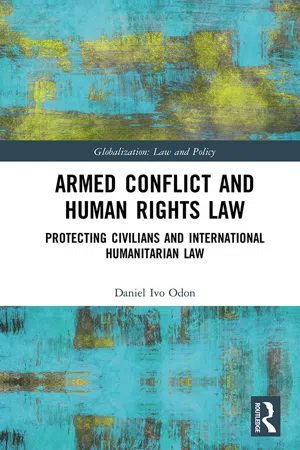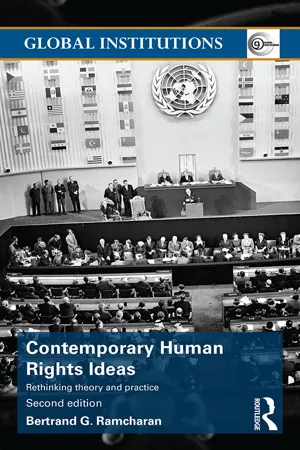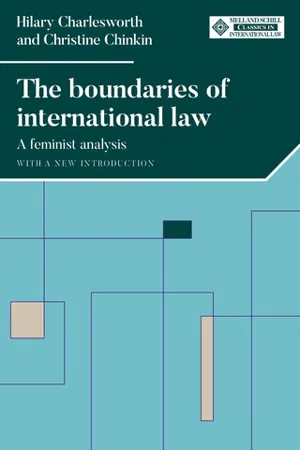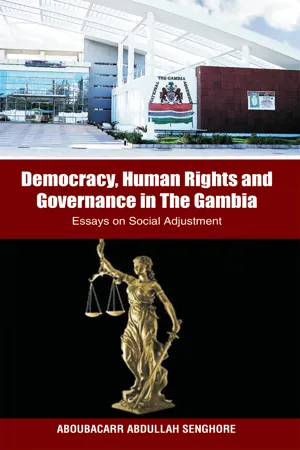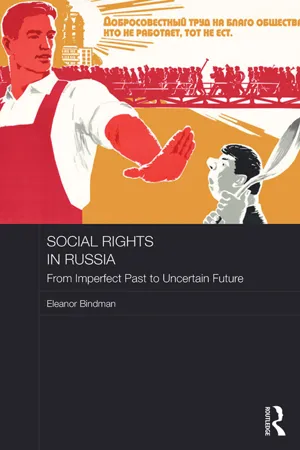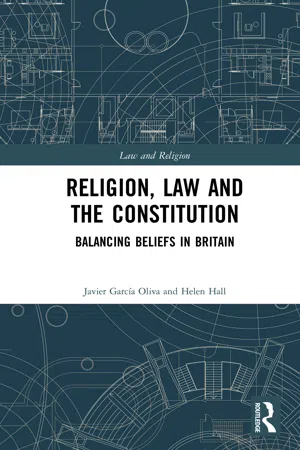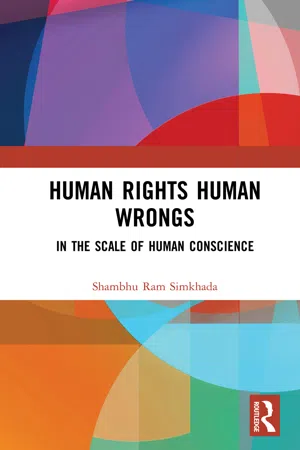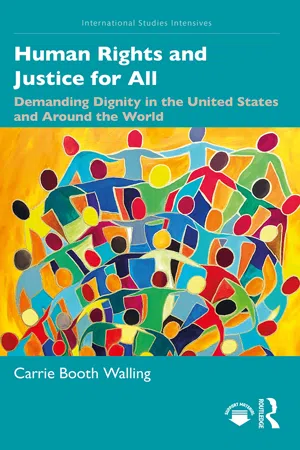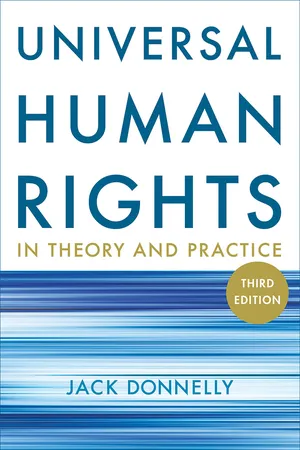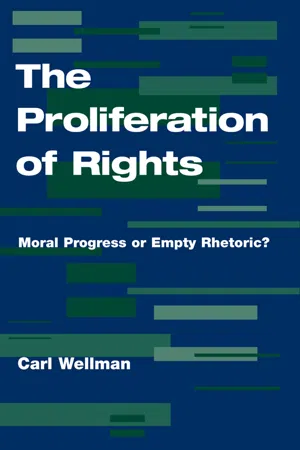Law
History of Human Rights
The history of human rights traces the evolution of principles and laws that protect the inherent dignity and worth of every individual. It encompasses key milestones such as the Magna Carta, the Universal Declaration of Human Rights, and various international treaties and conventions. The history of human rights reflects the ongoing struggle to secure and uphold fundamental freedoms and protections for all people.
Written by Perlego with AI-assistance
Related key terms
Related key terms
1 of 4
Related key terms
1 of 3
12 Key excerpts on "History of Human Rights"
- eBook - ePub
Armed Conflict and Human Rights Law
Protecting Civilians and International Humanitarian Law
- Daniel Ivo Odon(Author)
- 2021(Publication Date)
- Routledge(Publisher)
3 Human rights lawDOI: 10.4324/9781003170778-3Historical considerations
When we talk about human rights, we are talking about current politics and ethics that speak to both the international community and the histories of states, socio-economic structures, legal systems, religions and cultures. Within its legal dimension, therefore, internal state law usually mingles with international law and intergovernmental bodies in order to transform internal and international order. This “human rights movement” grapples for universal validity throughout the body of law, which has both horizontal and vertical strands that are equally important to legal concepts and moral development. The horizontal strand involves the widening process of constitutionalism among states through comparative law, while the vertical refers to the binding effect of international treaties on human rights held by international institutions.1In this sphere, however, we must draw a line in human history from the Second World War onwards, which reveals a change in approach. A bridge is usually built between the American and French revolutions in the eighteenth century and 1945. Despite several documents that are related to human rights historiography, we ought to focus our attention initially on the eighteenth century, when declarations of human rights were proclaimed in America and France, and then move forward.Although it is common to find some declarations of rights within the English Declaration of Rights of 1689, most human rights advocates do not cling to this. This declaration might be deemed the first declaration of rights, but it nevertheless remains attached to the medieval tradition and lacks the core elements of the ones that follow. Although influenced by the rationalism of the revolution that prompted it, it is still related to Middle Age precepts and the English parliamentary monarchy.2 - eBook - ePub
Contemporary Human Rights Ideas
Rethinking theory and practice
- Bertrand Ramcharan(Author)
- 2015(Publication Date)
- Routledge(Publisher)
1 History Shared heritage, common struggle • Law and justice: the common heritage of humanity • Respect for shared humanity in the major religious and philosophical traditions • The place of the individual in the community and the rights of groups and peoples • The common struggle for human rights • Positive rights • Natural rights • The public policy function of human rights • The contemporary role of international consensus and legislation • ConclusionEach time a man stands up for an ideal, or acts to improve the lot of others, or strikes out against injustice, he sends forth a tiny ripple of hope, and crossing each other from a million different centers of energy and daring, those ripples build a current that can sweep down the mightiest walls of oppression and resistance.(Robert Kennedy, 19661 )This chapter looks at historical aspects of the development of human rights and at the global quest for their implementation and vindication. The following strands are discussed: the shared heritage of humanity in the development of the ideas of law and justice; major religions’ emphasis on respect for shared humanity; the place of the individual in the community and the rights of groups and peoples; philosophical debates that have accompanied the evolution of rights; the idea of the individual’s positive rights; the idea of natural rights; the role of struggle and policy in the development of rights; and the role of international consensus and legislation in the contemporary concept of rights captured in the UDHR’s opening article: “All human beings are born free and equal in dignity and rights. They are endowed with reason and conscience and should act towards one another in a spirit of brotherhood.”2Law and justice: the common heritage of humanity3To understand and appreciate the contemporary concepts of law and rights, it is essential to have a sense of the common heritage of humanity in the development of these concepts (see Table 1.1 ). In Freedom in the Ancient World, the historian Herbert J. Muller noted that although ancient men scarcely believed that freedom and justice were one and inseparable as is now commonplace, “there has always been a real connection between them beginning with the necessity of law for any effective freedom. Law codes, written or unwritten, confer some rights in the very act of specifying obligations and penalties.”4 - eBook - ePub
The boundaries of international law
A feminist analysis, with a new introduction
- Hilary Charlesworth, Christine Chinkin(Authors)
- 2022(Publication Date)
- Manchester University Press(Publisher)
7 Human rights IntroductionThe notion of human rights describes what it is to be human and defines the ‘rock bottom of human existence’.1 Human rights law challenges the traditional state-centred scope of international law, giving individuals and groups, otherwise with very restricted access to the international legal system, the possibility of making international legal claims. In many ways, human rights law has been the most accessible and hospitable area of international law for women because it explicitly acknowledges women’s lives, albeit in a limited fashion. The aim of this chapter is to investigate the ways in which human rights law recognises and promotes the concerns of women and to assess its potential for the advancement of women’s interests. It begins with an account of the development of the human rights canon and feminist critiques of rights. The chapter then discusses women-specific human rights instruments and the reasons why they have not provided an adequate response to human rights abuses typically sustained by women. Finally, the chapter considers recent developments that suggest the potential of human rights law to protect the ‘rock bottom’ of women’s lives.The evolution of human rights lawModern human rights law derives primarily from Western philosophical thought dealing with the relationship between those who govern and those who are governed, although it also has some resonance in other cultural traditions.2 Of particular significance in its development have been the values of Judaeo-Christian morality, natural law principles and political theories associated with the rationalism of the French and American revolutions. These theories include Locke’s social contract and natural rights theories, Montesquieu’s theory of the separation of powers between the legislature, executive and judiciary, and Rousseau’s theory of the sovereignty of the people.3 - eBook - ePub
Democracy, Human Rights and Governance in The Gambia:
Essays on Social Adjustment
- Abdullah Senghore(Author)
- 2018(Publication Date)
- CENMEDRA(Publisher)
It has been the product of different powerful socio-cultural forces that have come together to constitute and shape human society. Consequently, human rights have become the meeting point of a large number of academic disciplines which sprang out of those socio-cultural forces i.e. historical, philosophical, religious, legal, social, cultural political and economic forces. 55 Thus, it is against this highly exciting background that the importance of international law of human rights and indeed the role of the United Nations and the regional and sub-regional systems in its rapid growth should be valued. Although the development of international human rights norms and standards predate the inception of the United Nations, it is a well-known fact that the end of the Second World War and the subsequent establishment of the UN had substantially contributed to the restructuring, definition and rapid growth and development of international law in general and the development and crystallization of international law of human rights in particular. The period from 1945 to the present day has been witnessing the fast growth and virtual crystallization of a new branch international law which has, in turn, drastically changed and reshaped the field of international legal and political relations among member countries of the community of nations. The long standing attitude of international law towards individuals as objects and not subjects has virtually been changed and the scope of its traditional doctrines of domestic jurisdiction and non-intervention in the internal affairs of a sovereign state has been drastically limited or narrowed down by the advent of international law of human rights. Since the end of the Second World War, a large number of human rights treaties, both global and regional, have been concluded under the auspices of the United Nations and other regional groupings, and then signed, ratified or acceded to and in some cases incorporated into domestic laws - eBook - ePub
Social Rights in Russia
From Imperfect Past to Uncertain Future
- Eleanor Bindman(Author)
- 2017(Publication Date)
- Routledge(Publisher)
Prior to engaging with the historical and political emergence of social rights, it is important to examine briefly the wider concept of ‘human rights’ within contemporary political philosophy in order to explore how ideas about the meaning and importance of social rights fit within this concept. Attempting to define ‘human rights’ presents a number of challenges given the inherent flexibility of the concept and the very different types of claim it is seen to cover. As Bunch (1990: 487) points out, this concept is ‘not static or the property of any one group; rather, its meaning expands as people reconceive of their needs and hopes in relation to it’. Dean (2015: 10) emphasises that the concept of human rights is both socially and ideologically constructed: ‘The history of the rights-bearing subject as “citizen”, “proprietor” and (more recently) as “human” is… a continuing story of shifting doctrinal orthodoxies and innovative claims-making’. Nevertheless, most commentators appear to agree that the concept of human rights as reflected in key instruments of international human rights law such as the Universal Declaration of Human Rights (UDHR) and the European Convention on Human Rights (ECHR) has its origins in seventeenth and eighteenth century concepts of natural law, which arose in response to the development of the nation-state in Europe and its increasing and often arbitrary power over its citizens. According to Mutua (2007: 550), ‘the rise of the modern nation-state in Europe and its monopoly over violence and the instruments of coercion gave birth to a culture of individual rights to contain the abusive state’. The idea of natural law implied certain natural rights pertaining to humans by the very nature of their being human and was perhaps most extensively elaborated by John Locke in his ‘Two Treatises on Government’ of 1689, in which he outlined his theory of a ‘social contract’ in which the right to life, liberty and property are perceived as natural rights and, upon entering into a civil society, humans surrender to the state only the right to enforce these rights, rather than the rights themselves (Locke 1689 in Weston 2008: 21). According to this liberal social contract theory, such rights are dependent on the noninterference of the state in the lives and liberties of its citizens and are often classified as ‘first-generation’ civil and political rights (Vasak 1977: 29; Yokota 2008: 8). This idea of using the natural ‘rights of man’ and some form of social contract between the state and its citizens as a means of limiting the arbitrary power of rulers and their governments continued to gain ground during the Enlightenment period as it was developed by radical thinkers such as Rousseau and Paine and exerted major influence during first the American Revolutionary Wars of 1776–1783 and then the French Revolution of 1789 (Paine 1792: 1996; Weston 2008). Dean (2015: 8) argues that, over time, the work of Locke, Paine and others established ‘a moral discourse by which “natural” rights were first recast as inalienable individual rights’ and then exchanged to become ‘civil rights under doctrines of liberal governance’. This moral discourse then formed what Dean (2015: 9) describes as the ‘liberal citizenship tradition’ which came to dominate political thought in the Anglophone world during and after the Enlightenment period. - eBook - ePub
Religion, Law and the Constitution
Balancing Beliefs in Britain
- Javier García Oliva, Helen Hall(Authors)
- 2017(Publication Date)
- Routledge(Publisher)
Of course, the overarching debate about the general and abstract interaction between human rights and religion is beyond the scope of this book. We are concerned with human rights as they exist within the legal framework of Great Britain, rather than the purely mental space of philosophical discourse, and the way in which the established Churches and other faith groups interact with these. In the case of the constitutional principles previously considered, we have seen that religious bodies are a positive force of advancement and support. Is this equally true of human rights?In order to address this, we shall begin by considering what is meant by human rights in this particular context as far as the legal system is concerned, before moving on to discuss whether the legal framework concerning religion enhances or weakens religious freedom. We shall then look at the way in which various religious groups view human rights in their understanding. Our discussion of the practical impact of faith communities on human rights, will be subsumed within our assessment of the religious legal framework, for reasons which will become apparent during the course of our discussion.7.2 What do human rights mean in the context of the UK Constitution? 7.2.1 Preliminary reflectionsHuman rights law, by its very nature, has an international dimension. As Robertson and Merrills8 observe, the world has moved a long way from the position outlined by Oppenheim at the start of the twentieth century, when public international law governed relations between states but did not operate to confer rights on individuals. Although there is still debate about the extent to which it is possible or desirable to limit the autonomy of sovereign states, there is now widespread acceptance of the idea that international instruments can and should invest individuals with rights.p.359Interestingly, as we saw in Chapter 1 - eBook - ePub
Human Rights Human Wrongs
In the Scale of Human Conscience
- Shambhu Ram Simkhada(Author)
- 2020(Publication Date)
- Routledge(Publisher)
2Human Rights: Historical Perspective and Contemporary DevelopmentLet hundreds like me perish, but let truth prevail—Mahatma GandhiHuman rights derive from human conscience and reason, reflected in the constant striving of the human race for peace, progress, freedom and justice. Moral and religious thinkers may stress the inherent dignity and equality of humans by virtue of their being the creations of God or stemming from the dignity of all creation. Human rights are best defined as rights by virtue of being human. Although numerous legal instruments and codes have emerged at the national and international levels, human rights in this sense are not the rights given by a government or a legal authority but much more fundamental rights derived from the essential nature of humankind. A Sanskrit sloka, Ahara nidra bhaye maithunani, samani chaitani nrinam pasunam, gyanam naranamadhiko bisesha, gyanena hina pashuvi samana,25 essentially says that in terms of need for food to survive, sleep or recuperation, fear and reproduction, all living beings are the same. In the absence of gyana (the inner conscience), human society becomes an animal kingdom. It is this conscience related nature that makes human rights different from other contractual forms of rights. This is what makes human rights natural and universal, and violation of some basic natural and universal rights of all human beings, right to life, for instance, under any pretext, politics, economics, religion, culture or tradition, class or caste, is a human wrong. Reaffirmation of the dignity and worth inherent in the human person, their preservation and promotion are the basis of all human rights and fundamental freedoms.25 Chanayka Niti Darpan - eBook - ePub
Human Rights and Justice for All
Demanding Dignity in the United States and Around the World
- Carrie Walling(Author)
- 2022(Publication Date)
- Routledge(Publisher)
1Understanding Human Rights as Lived Experience
DOI: 10.4324/9781003256939-2We experience human rights or their violation in deeply personal ways. We advance human rights or we fuel human wrongs through our choices, actions, and inactions. This book is about the fight for human rights – the contestation over their meaning, the politics of their recognition, the struggle by people for their realization, and the tools and tactics that support political change. For while we each have a claim to our human rights, too often they remain unfulfilled or are actively challenged by the decisions of political leaders and the practices of powerful institutions. When human rights are denied, they must be demanded and fought for. When they are achieved, they must be regularly exercised and actively protected. The claim to rights, and the responsibilities for them, belong to people in all regions of the world, all forms of government, and countries at all stages of economic development. Whether respect for human rights grows or their disregard widens depends on our embrace of equality or discrimination, pursuit of inclusion or exclusion, and support for justice or impunity. We learn more about human rights and human wrongs by examining them in the contexts in which they occur. The case studies in this text and the stories of the people who have struggled within them invite us to link ideas with practices and to consider how we can build a more equal, just, and rights-filled world. They invite us to imagine how we might “live human rights” at home and abroad.Human rights are the rights every human being is born with. Human rights are about more than survival; they include those things that are essential to a life of dignity. These rights never go away even if those in power do not recognize them – they are inalienable. Human rights are universal. They are different than the rights granted by governments to their citizens. All human beings are born with human rights, do nothing to earn them, and their rights travel with them wherever they reside and no matter what border they cross. All human beings are equal in dignity and rights. Equality means that they apply to all persons regardless of gender, sex, race, religion, nationality, economic status, ability, sexual orientation, ethnicity, political belief, age, or any distinction of any kind. Importantly, all human rights are interdependent and interrelated. This means that human beings must have access to all their rights to achieve dignity. The violation of any single right limits the enjoyment of other rights. Human rights are an entitlement. They are not simply good or desirable. They are not a gift. People suffer harm when they are deprived of the human rights to which they are entitled. Although human rights are seldom fully realized, and often violated, that does not mean they do not exist. Rather, it is the deprivation of our human rights that mobilizes political action to claim them. In sum, human rights are the rights that every human is entitled to and are necessary for a life of dignity. Human rights are inalienable, equal, and interdependent. - eBook - ePub
Social Work and Human Rights
A Foundation for Policy and Practice
- Elisabeth Reichert(Author)
- 2011(Publication Date)
- Columbia University Press(Publisher)
Historical Beginnings of Human RightsThe use of dignity frequently appears in discussions of human rights. Few people would deny that everyone should have dignity or that dignity forms a basis for human rights. The meaning of the term itself, however, is difficult to define. Although dignity can refer to the respect and acceptance of others, it otherwise seems to be used simply as a tool to inspire thinking about human rights. Documents issued by the United Nations often contain language that is intended to inspire and engage the reader, but by itself, dignity adds little to the understanding of specific human rights. More important is the actual analysis of human rights issues and how they can be made part of social work policy and practice.The Universal Declaration of Human Rights did not arise from a vacuum. Early civilizations created religious codes establishing standards of conduct for fairly homogeneous groups within limited territorial jurisdictions. By requiring people to treat their fellow humans with dignity and help provide for one another’s needs, such religious codes became the precursors of human rights. In varying degrees, Judaism, Christianity, Buddhism, Confucianism, and Islam all stress what now would be called human rights. These religions emphasize the necessity of fairness on the part of political authorities and the distribution of economic resources to those in need (Ife 2008; Laqueur and Rubin 1979; McKinney and Park-Cunningham 1997; Van Wormer 1997).More than two thousand years ago, great philosophers, including Plato and Socrates, explored the realm of basic, inalienable rights of man, which in those times strictly referred to men (Wronka 1998). (Women’s rights as human rights were not acknowledged until much, much later [Reichert 1996, 1998]). According to the Greek philosopher Aristotle, an unjust man is a man who is not content to have an equal share with others (Wronka 1998, 43). Since an unjust thing is an unequal thing, there clearly must be a mean between greater and less inequality. If then the unjust is the unequal, the just will be the equal. A bit later, the Romans developed the “Twelve Tables,” which stress the necessity for a proper trial, the presentation of evidence and proof, and the illegality of bribery in judicial proceedings (Wronka 1998, 46).In 1215, a cornerstone of human rights was laid when English nobles, bishops, and archbishops forced the then reigning King John to end all abuses against his subjects. As a record of his agreement, these men drafted a document known as the Magna Carta, which King John was forced to sign. The Magna Carta prohibited a sovereign from taking property without due process and detaining his subjects without a legal judgment by their peers, which was the forerunner of the trial by jury. The document also highlighted the importance of family and provided for safety from abusive treatment. - eBook - ePub
- Jack Donnelly(Author)
- 2013(Publication Date)
- Cornell University Press(Publisher)
1 For the purposes of international action, “human rights” means roughly “what is in the Universal Declaration.” I do not, for reasons outlined in the preceding chapter, attempt to give a philosophical account of human rights—let alone the “best” philosophical account. Rather, I treat the body of international human rights law as providing largely authoritative standards for all states in the contemporary world (compare sections 4.1 and 6.2.A). In this chapter I try to explicate the conceptual logic that underlies the Universal Declaration and the body of international human rights law to which it has given rise.1. The Universal Declaration
Most of us today take human rights to be a normal and “obvious” part of international relations. In fact, however, such an understanding goes back only to the end of World War II.The recognition of certain limited religious rights for some Christian minorities in the Peace of Westphalia (1648)—which brought the Thirty Years’ War to an end and is usually seen as inaugurating modern international relations—can be seen, with the benefit of hindsight, as an early precursor of the idea of international human rights. In the nineteenth century, international campaigns against the slave trade and slavery had clear overtones of what today we would call human rights advocacy. After World War I, workers’ rights and minority rights were addressed by the newly created International Labor Organization and the League of Nations. Nonetheless, prior to World War II the very term “human rights” was largely absent from international discourse. For example, it is not mentioned in the Covenant of the League of Nations, which is usually seen as an expression of the “idealism” of the immediate post–World War I era. Even those who believed that all human beings had an extensive set of equal and inalienable rights—a distinctly minority idea in an era that had little trouble justifying colonialism—did not suggest that other states had rights or obligations with respect to those rights.This changed decisively with the creation in 1945 of the United Nations, which took place in the shadow of not only an unusually vicious global war but also of the Holocaust. The preamble of the UN Charter lists as two of the four principal objectives of the organization “to reaffirm faith in fundamental human rights, in the dignity and worth of the human person, in the equal rights of men and women and of nations large and small” and “to promote social progress and better standards of life in larger freedom.”2 - eBook - ePub
- Shazia Choudhry, Jonathan Herring(Authors)
- 2010(Publication Date)
- Hart Publishing(Publisher)
Much has been written on the jurisprudential basis of the nature of rights. It is not the aim of this Chapter to contribute to that. However, before seeing how an approach based on human rights can be used to tackle those questions which trouble family lawyers it is necessary to have a clear view on what rights are. This Chapter will be in three parts. First, the issues surrounding the definitions and forms of human rights will be discussed. Second, the benefits of adopting a human rights approach will be outlined. Third, the difficulties in utilising human rights in the context of family law will be discussed. As explained in Chapter 1, in our view following the HRA judges have no alternative but to use human rights analysis in considering family law cases under English law. To debate whether or not human rights approaches are useful is therefore a rather sterile exercise. However, an awareness of the potential benefits and disadvantages of the use of rights in the family law context will be essential if rights are to be used effectively.Rights: Definitions and Understandings
Lord Steyn, writing extra-judicially, has written:A constitutional democracy must protect fundamental rights. It is morally right that the state, and all who act on its behalf in a broad functional sense, should respect the fundamental rights of individuals. Without such a moral compass the state is bound to treat individuals arbitrarily and unjustly.[6]Such an approach puts human rights at the heart of a properly functioning democracy and is essential for the protection of individual freedom.[7] Most commentators agree that rights are important and accept that in some sense they protect individuals from the power of the State. But beyond that there is little agreement over how they work.What is a Right?
The claim that A has a right to X is a strong one. It is not just saying that it would be nice if A had X, but rather that A has an entitlement to X. It would be good if we could be given freshly squeezed grapefruit juice for breakfast. Indeed that would be good for us - eBook - ePub
The Proliferation Of Rights
Moral Progress Or Empty Rhetoric?
- Carl Wellman(Author)
- 2018(Publication Date)
- Routledge(Publisher)
During the nineteenth century, natural rights theories were increasingly ignored or even rejected. Probably this was due in large part to the influence of Jeremy Bentham, an exponent of classical utilitarianism, which maintained that the moral standard of individual actions and social institutions is whether they promote or prevent human happiness. Alarmed by the violence of the French Revolution, he argued that declarations of natural rights are groundless, dogmatic assertions leading to anarchy and that the only real rights are legal rights. Later moral philosophers were by and large skeptical of the existence of any personal God to legislate the law of nature and of any self-evident truths to enunciate it. Political philosophers looked to utilitarianism rather than natural rights theory as the basis for social criticism and legal reform. Most jurists adopted legal positivism, the view that whatever rules are posited or willed by legislative or judicial action are valid law. According to legal positivism law and morals, including legal and moral rights, are logically distinct and radically separate. Lawyers became almost completely absorbed in the empirical facts of legislation and adjudication and uninterested in the moral standards they thought irrelevant to their legal practice.In the twentieth century, however, there was a marked revival of interest in the natural rights of man. This revival reflected two world wars that not only caused the death of vast numbers of individuals and the destruction of immense amounts of property but also exposed the world to the dreadful experience of totalitarian regimes, especially in Nazi Germany, that grossly violated the basic rights of so many human beings. These fundamental moral “rights of man” were renamed “human rights” to avoid any insinuation that only males are qualified to possess them and to eliminate the dubious presuppositions of traditional theories of natural rights.Hence, the development of human rights as such began in 1945 when the United Nations Charter reaffirmed faith in fundamental human rights and announced that one of its primary purposes was “to achieve international co-operation… promoting and encouraging respect for human rights and for fundamental freedoms for all without distinction as to race, sex, language, or religion.”1
Index pages curate the most relevant extracts from our library of academic textbooks. They’ve been created using an in-house natural language model (NLM), each adding context and meaning to key research topics.
Explore more topic indexes
Explore more topic indexes
1 of 6
Explore more topic indexes
1 of 4
